
Dmitri Shostakovich (1906-1975)
Cello Concerto No.1, Op.107 (1959)
Cello Concerto No. 2, Op.126 (1966)
Yo-Yo Ma (cello)
Boston Symphony Orchestra/Andris Nelsons
rec. 2023, Symphony Hall, Boston, USA
Reviewed as a download
Deutsche Grammophon 4866949 [63]
On this fascinating disc Yo-Yo Ma returns to the First Shostakovich Cello Concerto after a gap of over forty years and adds his first ever recording of the Second. Two notable milestones given the essential status of both concertos in the modern repertory and the eminence of the soloist. The catalyst for this new issue is the desire by DG to add the Cello, Violin and Piano Concertos to the set of the Shostakovich Symphonies recorded by the Boston Symphony Orchestra and Andris Nelsons (DG 4866649). Whatever one’s views on the addition of more monumental box sets to an already rich catalogue – and I have had mixed feelings about the recordings of the Symphonies as they’ve been released – all of the discs of the Concertos have something special to offer, and perhaps this one most of all.
Ma’s first recording of the First Concerto was with Ormandy and the Philadelphia Orchestra (Sony), released in 1983 when Ma was still in his twenties. It’s vivacious, gritty, sardonic and, particularly in Ma’s playing of the imposing cadenza movement, overtly virtuosic. It compares very favourably with Ormandy’s recording of the same work twenty three years before with Rostropovich (Sony) which I find surprisingly lugubrious in places. The next thing you’ll be expecting me to write is that the earlier Ma rendition sounds like a young man’s performance, and well, yes, it does, but I’m confident that anyone hearing a comparison of the solo playing in these two recordings would be hard placed to identify which was the earlier, at least until that cadenza.
I was captivated by Ma’s all-out attack in the cello’s famous opening theme in this new recording. He relishes every note and positively invites the orchestral dialogue which follows. It’s almost as if he driving the woodwind in particular to distraction with his persistence and I loved the ever more frantic response of the Boston flutes and clarinets. The whole movement feels as if it’s treading a line between order and chaos, both temperamentally and musically, and all credit to Ma, Nelsons and the orchestra for holding their nerve and pulling it off. Ma and the Boston strings beautifully evoke the very different mood of the second movement. This is not quite the romantic world of, say, the slow movement of the Second Piano Concerto, but it’s close, and Ma’s playing is sublime, his rendering of the movement’s first theme in harmonics towards its close heartstopping, and the way he bridges to the cadenza perfectly judged. It’s here, perhaps, that the older Ma is a little more muted in spirit, a little more introverted, dare I say thoughtful, before the final Allegro con moto rushes us breathlessly to the end. Again, Nelsons leads a pacy, frenetic, edge-of-the-seat interpretation, which absolutely works.
Only six years or so separate the two Shostakovich Cello Concertos, but I am always struck by what feels like a world of difference between the two and the general sombreness of the Second. It’s explicable biographically given it was written on the back of Shostakovich’s hospitalisation and subsequent convalescence in the Crimea, where the composition was completed. Although a large orchestra is required, Shostakovich’s use of it is remarkable. For most of the time, it sounds as if only chamber forces are playing, so when the full ensemble is called upon, the effect can be overwhelming and highly dramatic, if something of a nightmare for the conductor. Nelsons again very capably performs a balancing act here, albeit a more subtle one than in the First Concerto, and Ma captures the essentially contemplative nature of the work with typical astuteness. The way he partners with the Boston players for much of the performance, almost as if it were indeed a chamber work, is a joy. I don’t know of another performance that so perfectly fits Shostakovich’s description of the work as ‘the Fourteenth Symphony with a cello part’. The way the work’s finale, in particular, unfolds here is compelling. Ma and the orchestra go from subdued to capricious to frenetic in what feels like the blink of an eye, but then the slow fall to just a distinctive Shostakovian use of percussion against Ma’s beautifully sustained low D is mesmerising.
This feels as if it will be an essential acquisition even at this relatively early stage of the Shostakovich anniversary year. If you don’t know it, do seek out the earlier Ma performance of the First Concerto though. It has the considerable bonus of what I think is the best performance on record of the Kabalevsky Cello Concerto No 1. The recorded sound on this disc from Boston Symphony Hall is excellent. DG’s booklet notes are adequate, although I thought Harlow Robinson’s foray into personification when he asks of that passage I have just described at the end of the Second Concerto, ‘Could this be death knocking at the door?’, somewhat unimaginative.
Dominic Hartley
Buying this recording via a link below generates revenue for MWI, which helps the site remain free



















